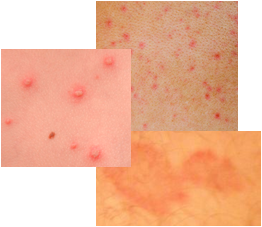Seborrheic Keratosis
Visit this
PICTURES OF RASHES PAGE
Seborrheic keratosis is a skin growth that is often mistaken for skin warts. However, this type of keratosis is not a wart because it does not contain the wart-causing virus. The growth is benign and will not progress to skin cancer. It is not contagious and the cause for the most part is unknown. There is a suspected hereditary and sun exposure link, although these growths can appear on non-sun exposed skin areas as well. Seborrhoeic keratosis affects individuals over the age of 30 much more frequently than younger individuals. They are one of the most common types of growths in adults and especially elderly individuals.
Symptoms of this Skin Problem
The growths associated with seborrheic keratoses come in different shapes (usually round to oval) and colors (black, brown, or tan). Most of the seborrheic growths are small, but it is not unusual to have some grow to over 3 cm or one inch in size. One single growth may be present or a group in the same area. The surface of the growth can be smooth and waxy looking containing tiny bumps or rough and resembling the typical cauliflower appearance of skin warts (bumpy and grainy). They are described as growths that are simply stuck on the skin or in other words, they are not attached deep into the skin. Instead, they are attached to only the top layer of the skin and this gives the appearance that the keratosis can be easily picked off the skin. Although painless, itching is a coming symptom or common complaint associated with a seborrhoeic keratosis growth. Skin areas usually affected include the chest, shoulders, or back. However, other skin areas including the face are susceptible.
Seborrheic Keratosis Treatment Options
Treatment of seborrheic keratoses is not required. However, individuals may pursue a treatment because of the annoying itch, uncomfortable feelings due to friction with clothing, or simply for cosmetic reasons. Sometimes the constant rubbing of clothing against the growth causes it to bleed regularly. This creates pain and the possibility of infection. In these situations, individuals often will consider a keratosis treatment.
Proper diagnosis is the first step to treatment. It should be established by a physician that the growth is keratosis and not skin cancer or some other skin ailment.
Like warts, liquid nitrogen can be used to freeze the keratoses and thus destroy the affected skin cells.
Shaving or scraping of the growth is an option because it is not deeply attached to the skin.
Electrosurgery uses an electric current to burn off the keratosis and might be another option.
All of the above seborrheic keratosis treatments should be administered by a physician in order to reduce complications that may occur such as infection or scarring.
More information on different types of keratosis:
keratosis | actinic | actinic cheilitis | follicular | pilaris | seborrheic keratosis | senile
